Related Research Articles
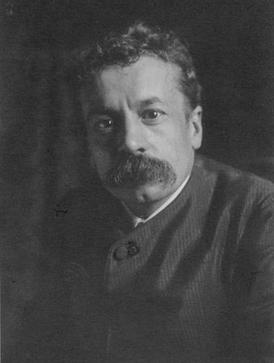
René Jules Lalique was a French jeweller, medallist, and glass designer known for his creations of glass art, perfume bottles, vases, jewellery, chandeliers, clocks, and automobile hood ornaments.

Louis Comfort Tiffany was an American artist and designer who worked in the decorative arts and is best known for his work in stained glass. He is the American artist most associated with the Art Nouveau and Aesthetic movements. He was affiliated with a prestigious collaborative of designers known as the Associated Artists, which included Lockwood de Forest, Candace Wheeler, and Samuel Colman. Tiffany designed stained glass windows and lamps, glass mosaics, blown glass, ceramics, jewellery, enamels, and metalwork. He was the first design director at his family company, Tiffany & Co., founded by his father Charles Lewis Tiffany.

Stained glass is coloured glass as a material or works created from it. Throughout its thousand-year history, the term has been applied almost exclusively to the windows of churches and other significant religious buildings. Although traditionally made in flat panels and used as windows, the creations of modern stained glass artists also include three-dimensional structures and sculpture. Modern vernacular usage has often extended the term "stained glass" to include domestic lead light and objets d'art created from foil glasswork exemplified in the famous lamps of Louis Comfort Tiffany.
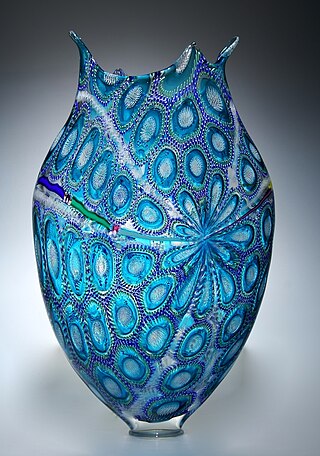
Studio glass is the modern use of glass as an artistic medium to produce sculptures or three-dimensional artworks. The glass objects created are intended to make a sculptural or decorative statement. Though usage varies, the term is properly restricted to glass made as art in small workshops, typically with the personal involvement of the artist who designed the piece. This is in contrast to art glass, made by craftsmen in factories, and glass art, covering the whole range of glass with artistic interest made throughout history. Both art glass and studio glass originate in the 19th century, and the terms compare with studio pottery and art pottery, but in glass the term "studio glass" is mostly used for work made in the period beginning in the 1960s with a major revival in interest in artistic glassmaking.
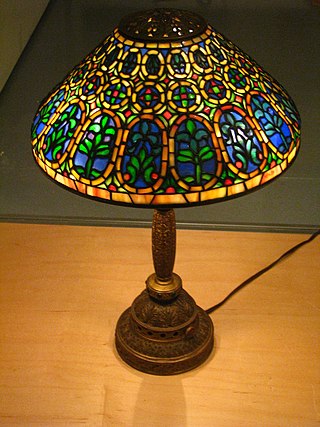
A Tiffany lamp is a type of lamp with a camed glass shade designed by Louis Comfort Tiffany or colleagues, and made in his design studio. The glass in the lampshades is put together with the copper-foil technique instead of leaded, the classic technique for stained-glass windows. Tiffany lamps are considered part of the Art Nouveau movement. Considerable numbers of designs were produced from 1893 onwards.
The firm of James Powell and Sons, also known as Whitefriars Glass, were London-based English glassmakers, leadlighters and stained-glass window manufacturers. As Whitefriars Glass, the company existed from the 17th century, but became well known as a result of the 19th-century Gothic Revival and the demand for stained glass windows.
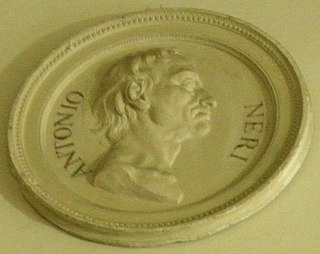
Antonio Neri was a Florentine priest who published the book L’Arte Vetraria or The Art of Glass in 1612. This book was the first general treatise on the systematics of glassmaking.
Judith Schaechter is a Philadelphia-based artist known for her work in the medium of stained glass. Her pieces often use symbolism from stained glass and Gothic traditions, but the distorted faces and figures in her work recall a 20th century German Expressionist painting style and her subject matter is secular. Shaechter's work often involves images that might be considered disturbing such as death, disease, or violence. Early Schaechter pieces, for example, such as King of Maggots and Vide Futentes make use of memento mori, symbols of death found in church architecture during medieval times.

Stanislav Libenský and Jaroslava Brychtová were contemporary artists. Their works are included in many major modern art collections, such as the Metropolitan Museum of Art and the Victoria & Albert Museum.
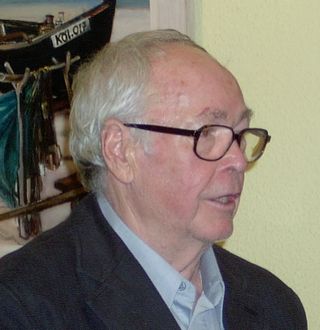
Walter Womacka was a German Socialist Realist artist. His work was pioneering early German Democratic Republic (GDR) aesthetics.

An Túr Gloine was a cooperative studio for stained glass and opus sectile artists from 1903 until 1944, based in Dublin, Ireland.

Glass art refers to individual works of art that are substantially or wholly made of glass. It ranges in size from monumental works and installation pieces to wall hangings and windows, to works of art made in studios and factories, including glass jewelry and tableware.

Robert Kehlmann is an artist and writer. He was an early spokesperson for evaluating glass art in the context of contemporary painting and sculpture. His glasswork has been exhibited worldwide and is the focus of numerous commentaries. Kehlmann's work can be found in museums and private collections in the United States, Europe and Asia. He has written books, articles, and exhibition reviews for publications in the U.S. and abroad. In 2014 the Rakow Research Library of The Corning Museum of Glass acquired Kehlmann's studio and research archives.
Peter Mollica is an American stained glass artist.
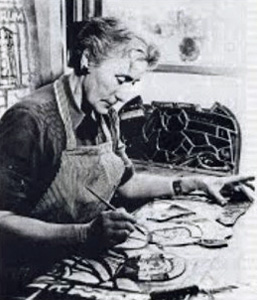
Katharine Lamb Tait was an American stained glass and mosaics designer, painter, muralist, and illustrator. She was the head designer at J&R Lamb Studios for more than four decades, and created notable commissions for the Tuskegee Institute Chapel and for chapels at the United States Marine Corps’ Camp Lejeune, among others.

Sylvia Dwyer (1912–1985) was an expressionist painter, art critic, and the founder and director of the Brooklyn Arts Gallery, the first art gallery in Brooklyn, New York.

Lewis Foreman Day was a British decorative artist and industrial designer and an important figure in the Arts and Crafts movement.

Frederick Wilson was a British stained glass artist best known for his work with Tiffany Studios. He was a prominent designer of ecclesiastical windows in the United States during the late 19th and early 20th centuries.
Susan Stinsmuehlen-Amend is a glass and mixed media artist who lives and works in Ojai, California.

Lucien-Léopold Lobin was a French stained glass artist and painter. Lobin was a student of H. Flandrin.
References
- Encyclopædia Britannica
- Larousse dictionary/encyclopedia (in French)
- Grand dictionnaire terminologique, Québec government's online dictionary (in French)
- Reverso online dictionary (in French)
- Mediadico online dictionary (in French)